
by admin | Dec 9, 2014 | Cinematography, Education, featured
a Super 16mm black & white short film.
One week ago I got the final grading of a short – film I shot last December on Super 16mm before starting uni, Food Fight, and I thought that it could be interesting to share the whole process.
I met Food Fight’s director, Natasha Waugh, while shooting a different project and as I had three cans of 16mm film stock at home that I was not going to use I asked her: Do you want to shoot something, maybe an experiment, with this? It has to be really short because we only have three cans!
After thinking about it, she came up with a short story about two food critics that get reunited in a restaurant and start talking about what happened in their previous date.
Pre – production…
Natasha wanted a 40′s / 50′s style and we decided that Black & White with a lot of contrast could be an interesting option so we started searching for the right place to shoot at.
After a couple of days going to restaurants, we went to a marvelous place a bit out of the city centre in Dublin called Cafe En Seine and we soon discovered that it was going to be our place as it had this extremely baroque decoration in the upper floor and we were going to have a lot of space to place the camera there too.
Hence, once we had the place, we started to see the different problems that we were going to have:
- The restaurant was going to be open while filming and that is something terrible as she would have to deal with background noises and things that she might not want in her short – film.
- We could only shoot for a very short span of time as the floor where we were going to shoot at had to be open to public around 6pm so we would have to finish shooting at 5pm and we were going to start around 10.30am / 11am.
- As we wanted to have a lot of contrast in the image and a very dark areas I felt that the backgrounds were going to be really dark and as I love practicals I decided I wanted to place a visible single fluorescent in one background to help create the illusion of contrast and also for it to give me a bit of kick light.
This background was the guy’s background and as he is the male of the story I wanted him to feel a tad rougher and mysterious than the girl who does not have that amount of light on her side and is treated gentler than the guy in terms of light.
- We knew that we wanted to shoot with an aspect ratio of 1:2.40, however, the camera that we were going to use did not have 1:2.40 frames so we had to create them with a bit of cellotape and a pencil.
We were talking about shooting a 10 minutes short – film in around 6 hours hence I had to be quick and smart and I did not have to take a lot of time putting lights for each camera movement (which is what I had loved!)
To get the mood of the short – film we shot a couple of 35mm black and white rolls with different processes to see if we really liked black and white or if we wanted more density, or more grain, or less contrast, etc.. all those tests that a cinematographer loves shooting while in pre – production!
And we fell in love with four things, black and white, grain, contrast and how film rendered the high – lights so we decided that although the story was a comedy we were going to shoot it as if it were something a bit darker.
To shoot the whole short – film we said: let us be smart, shoot a master and then coverage in two sizes and that is all, you will have your short – film in time and you will have enough things to cut it with.
The whole shooting list is in the image below, not too long though!
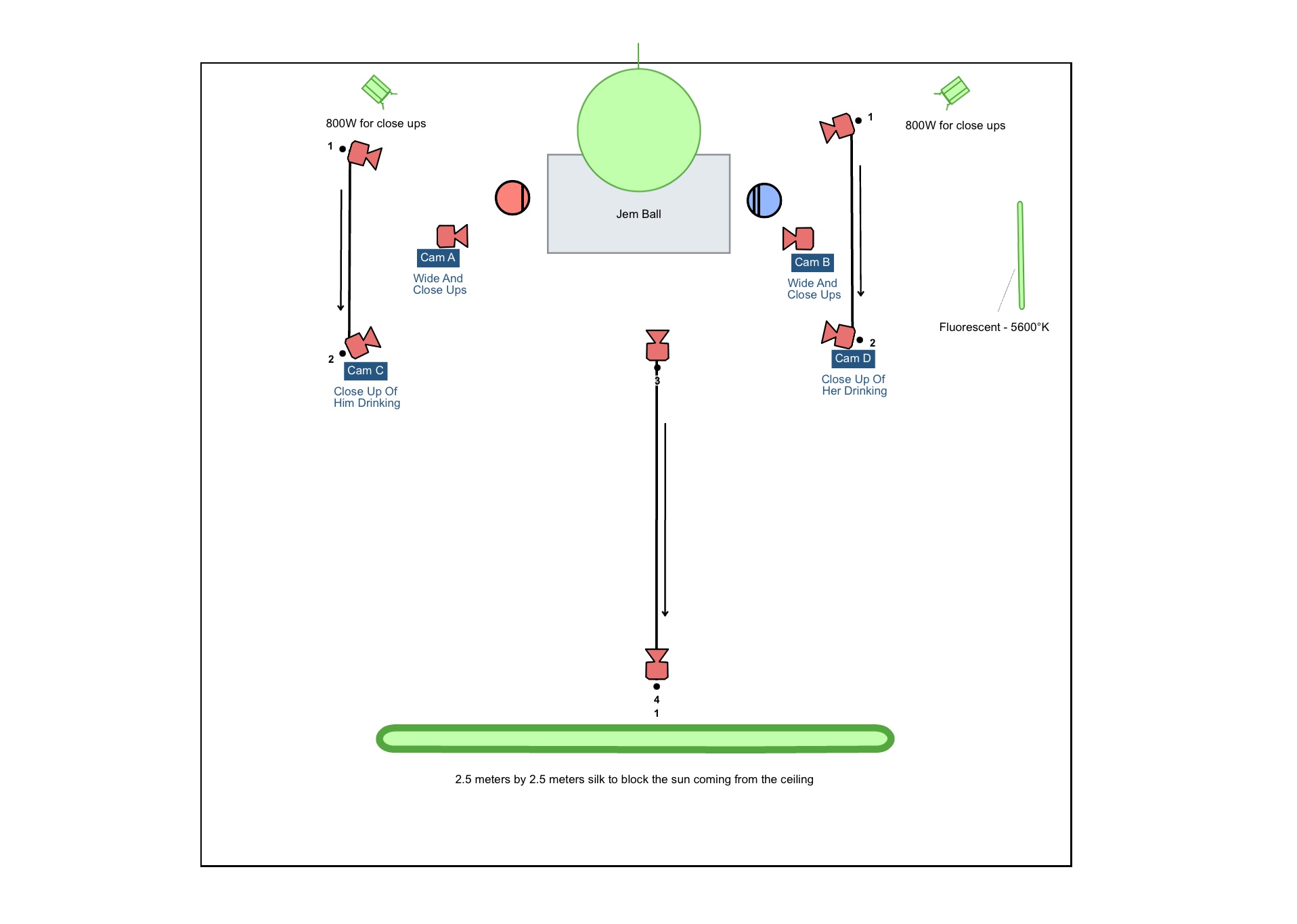 The lighting equipment list was very short, as I said, I did not have a lot of time to put lights.
The lighting equipment list was very short, as I said, I did not have a lot of time to put lights.
Lighting list
- 1 x Jem Ball
- 2 x 800w redhead
- 1 x Fluorescent tube
- 1 x Black silk 2.5meters by 2.5 meters
- 2 x Flags 1.5 meters by 1.5 meters
- 1 x White / Black polyboard
- Open roll Cinegel #3402 Rosco N3
- Open roll Cinegel #3403 Rosco N6
- Open roll Cinegel #3404 Rosco N9
I would have loved to have Chimeras for the Redheads but we could not get them due to budget reasons, at the end of the day, this was kind of an experiment!
…On set…
As we did not have a lot of time I decided to go with the Jem Ball for an ambient light and use it to light the faces, which I was going to underexpose.
I wanted her face in the zone 4 with a gradient towards the zone 5 so the reading for the zone 4 was T2.8 and I wanted his face in the zone 3 towards the zone 4 so I adjusted the Jem Ball when shooting his scenes.
Seeing the images now it is my thought that if I had put a diffusion frame under the Jem Ball I would have gotten a better quality of the light and the gradient between the light and the shadow would have been a bit wider, next time!
I used the Red Heads for the three quarters kick light (T8 1/2), zone 7+, and then let the fluorescent explode (T22 1/2), zone 9+, I decided to go further with the fluorescent during the grading and I left it super over exposed.
I wish I had had the time to think twice about some things as nowadays I reckon I should have put a fill light in their faces in the close ups and a fill light and a rim light in the wide shot too to help separate them from the background more.
My T Stop was going to be T4 but I hesitated a bit and I put T4 1/2.
I like really dense blacks!, if I were going to shoot it today, I am sure I would put T2.8 2/3 or T4 though.
We shot on Fujifilm Eterna Vision 250D with Tungsten sources, mainly because it was the film stock I had, we wanted to push it 1 stop to get more grain and also because I feel that tungsten lights look less artificial, I also exposed at 500ASA because I wanted to see the effect of not having that extra thing that you get exposing at 400ASA and I have to say that I will expose for 400ASA next time.
And here are some of the frames, click on them to see them better.
Frame 001
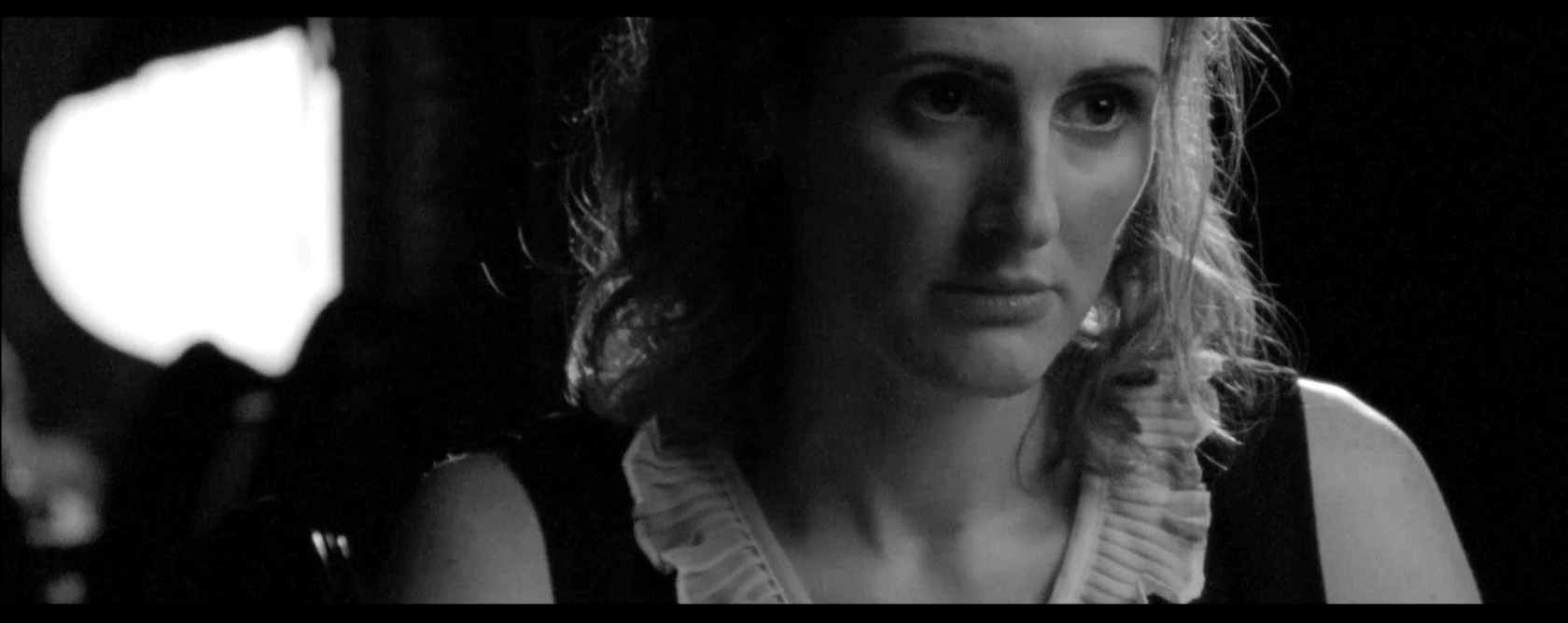
Frame 002
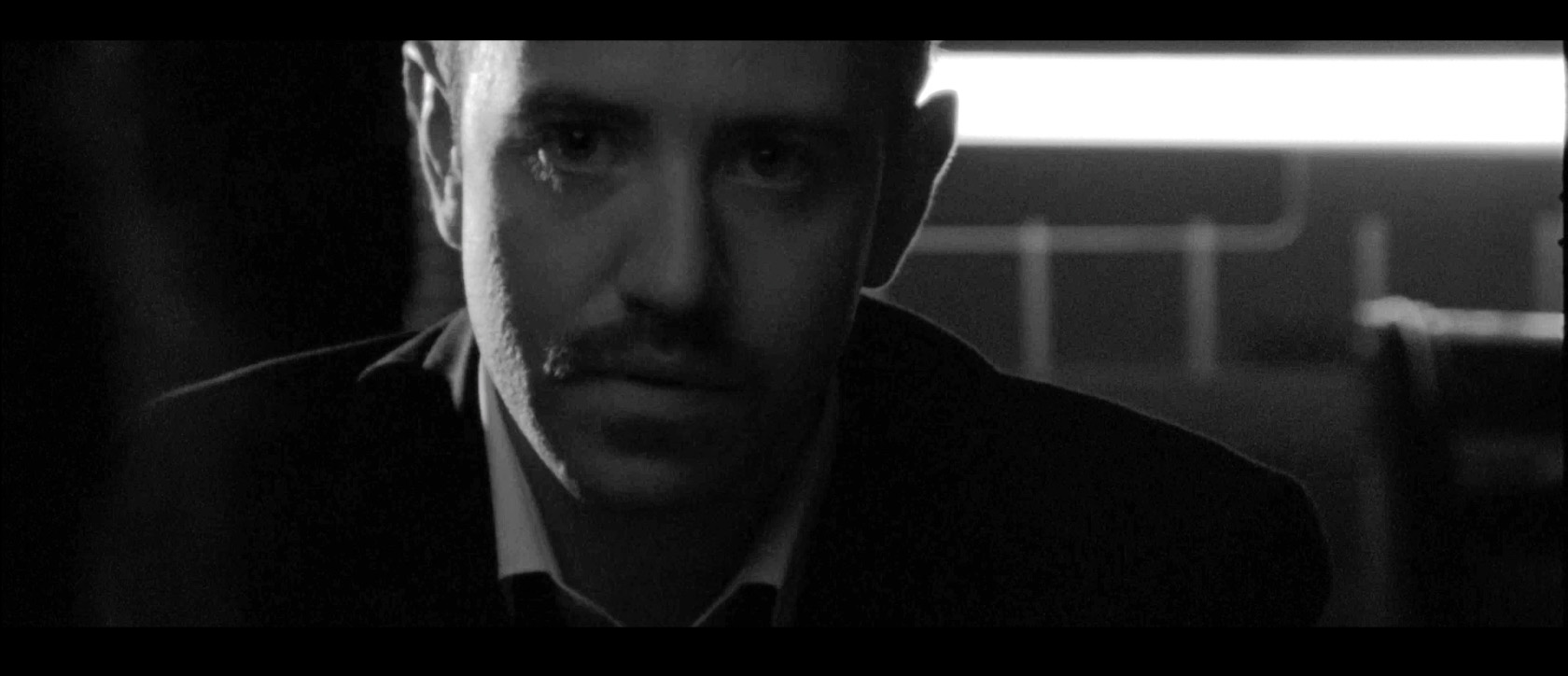
Frame 003
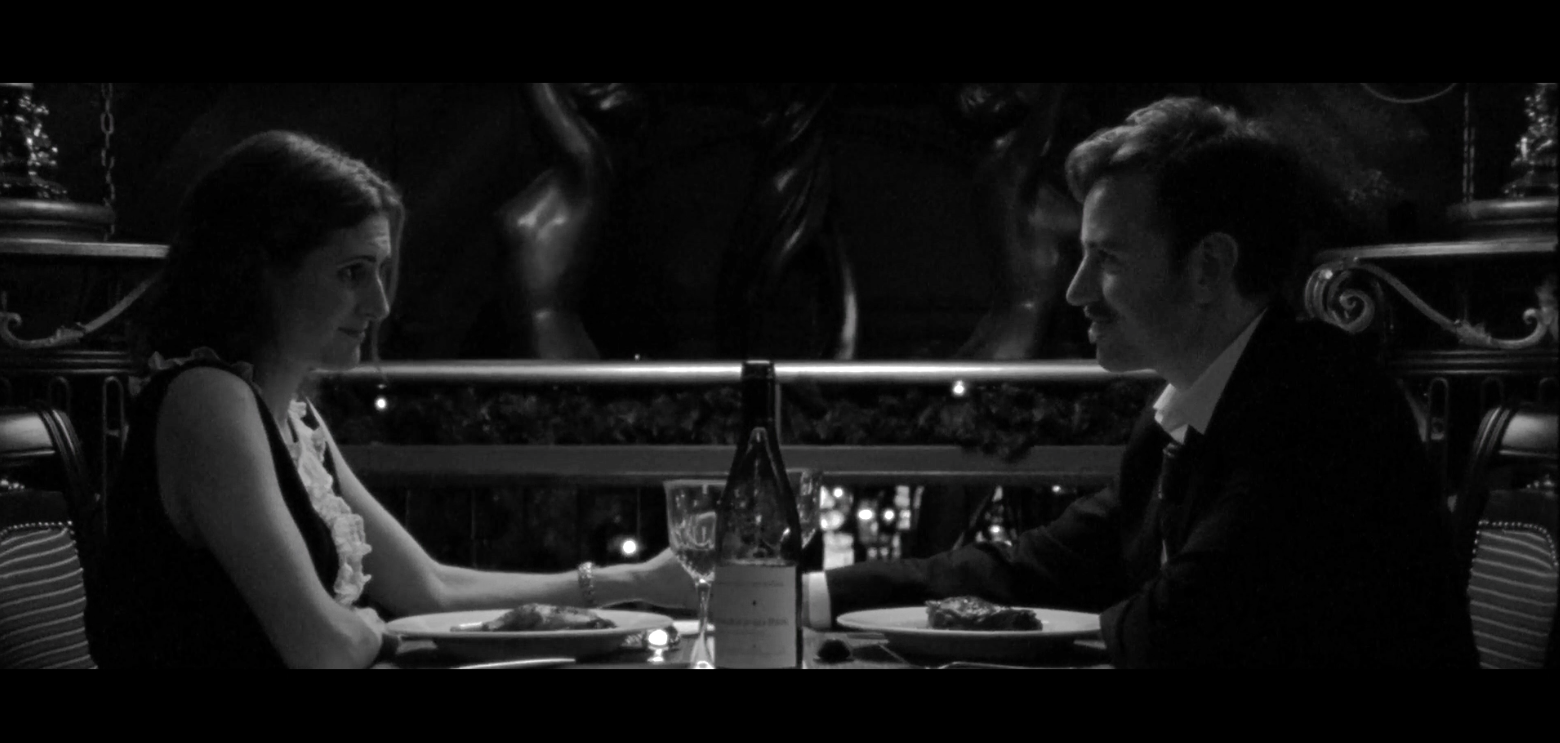
Frame 004
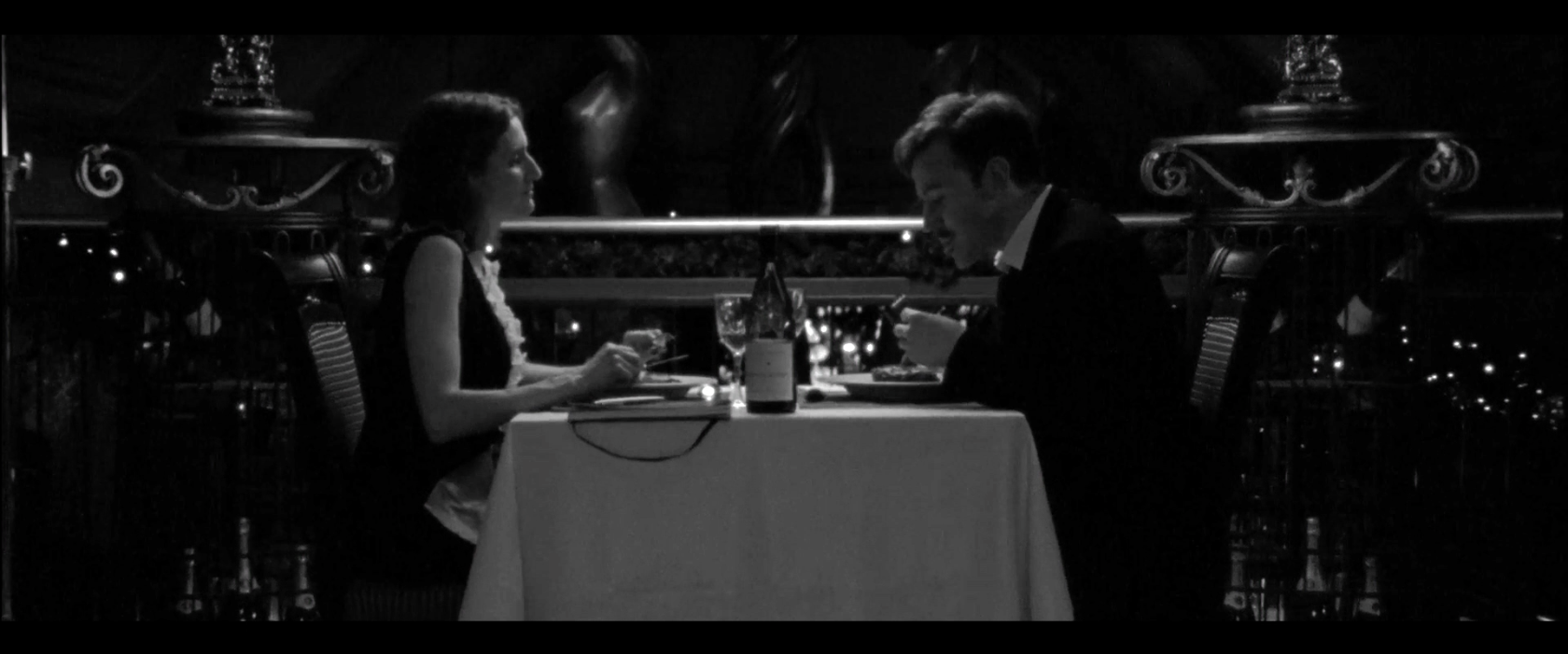
Frame 005
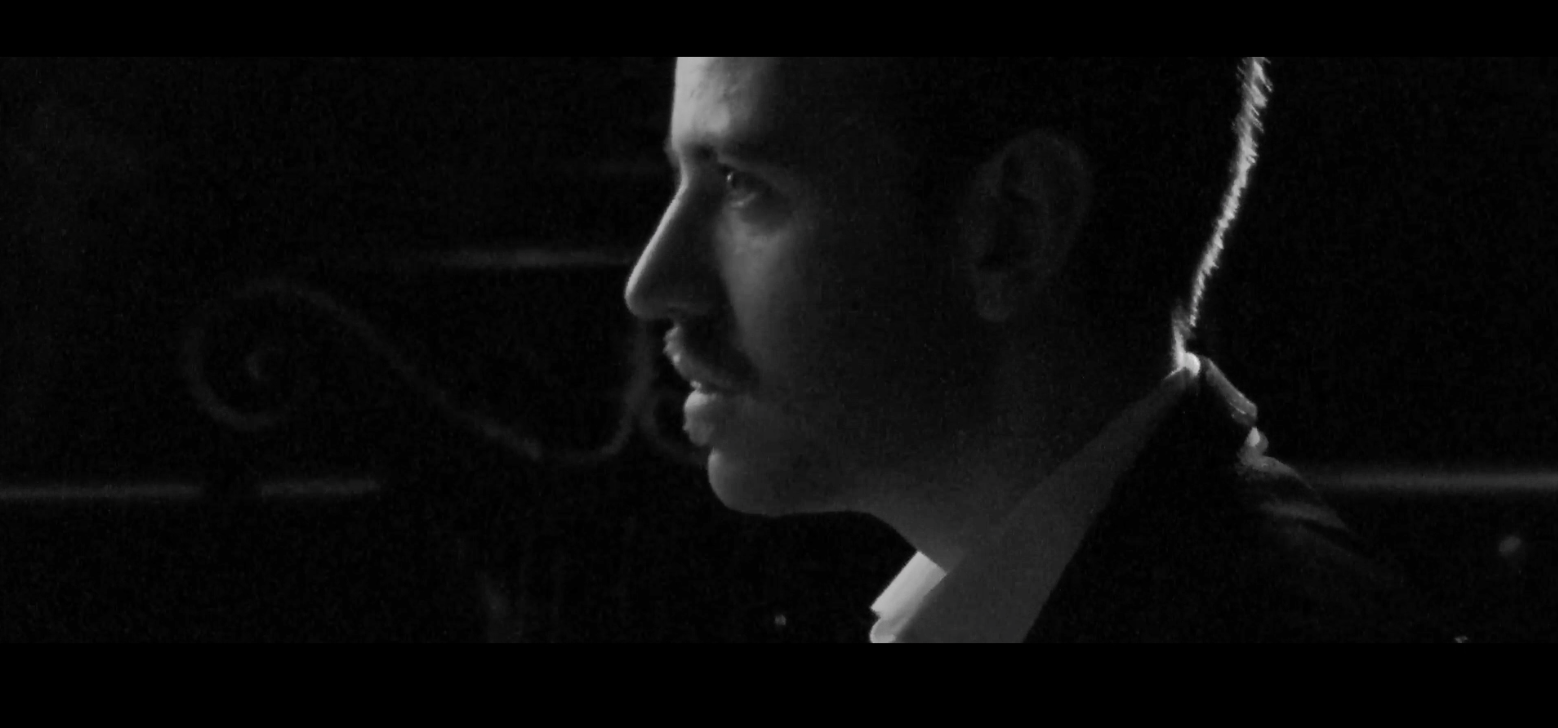
…Post production…
When we finished shooting, we sent the film stock from Dublin to London, to Cinelab London which took care of the negative from the beginning of the development to the end.
They really did a fantastic job and I cannot but recommending it as it is a superb lab!
We got a ftp address from where we were able to download the short – film (they sent us a HDD with the full project inside too) and once we got everything, we sent it to Mordisco Films a post – production company in Spain where one of the best colorist in Spain, Alberto Díaz, took care of it and delivered an amazing black and white image full of density and life.
And that is all!
I hope you enjoyed the reading!
Miguel Ángel
www.miguelangelvinas.com
_______________________________
Short – Film Details
Director: Natasha Waugh
Producer: Natasha Waugh for Fightback Films
Cinematographer: Miguel Angel Viñas
First Assistant Camera: Curtis Morris
Gaffer: Oisin Lowry
Spark: Michael Gilbert
Lab: Cinelab London
Camera Rental House: Filmbase Dublin
Lighting Rental House: Teach Solais
Color Grading: Al Díaz (Mordisco Films)

by admin | Jun 1, 2014 | Cinematography, Education
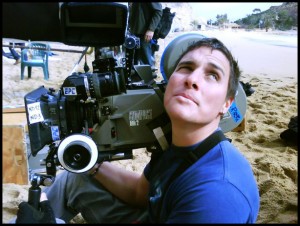 Working with an Arri Alexa
Working with an Arri Alexa
This week we meet ‘Miguel Ángel’, A spanish cinematographer who is working in Ireland. He has recently finished working on a period short film called ‘Staccato’ directed by ‘Eoghan McQuinn’
While studying Still Photography at University in Spain, I became fascinated with cinema and the moving image.
I cannot tell how much I love experimenting with different formats and aesthetics, something that I like translating to the projects I shoot.
We are delighted that Miguel has decided to share some insights when working with the Arri Alexa camera, In this wonderful diary he explains his process from the pre-production stage right up to shooting on the day, take it away Miguel…
Pre-production
I met the director, Eoghan McQuinn, through a post on filmmakersnetwork.ie a website I always recommend. He was looking for a producer and I sent him an email offering my help and asked him if he had a cinematographer for the project already. His answer was super! and he sent me a very first draft of the script, which I really really loved. After some emails, we decided to meet up and I have to say that I was both, afraid and nervous. When I first meet a director something happens in my stomach, it is kind of a knot plus some interesting feelings very hard to describe. Let’s say that after a conversation with a director, I never know what is going to happen next!
Fortunately Eoghan called me back and asked me to become the cinematographer of his impressive story, Staccato. And then, the fun began! and we started working together to bring Staccato to the set first and to the audience later!
Our first meet up was around September / October if I do not remember badly and through different conversations, ideas, visual references, moods, movies, etc, we created a style for the project.
I created a Cinematography breakdown which I will link at some stage when the short – film goes into festivals. It is a 120ish pages document with a lot of references, thoughts and ideas. Some of them are in the short – film, some of them are not.
I am a very organised person, and as a cinematographer I think that a project this size had to be shot or storyboarded before hand.
There is one thing I do always, I ask for some days with the following people:
- Director
- Producer
- Actors or Stand – ins
- Gaffer
- 1st Assistant Camera
- Grip
When we have everybody on board then we go to the different places where we are going to shoot and the director and myself photograph and shoot the whole piece with a DSLR or a little camera, we put it all together either on a video or on a board. That way, everybody knows what we want to do, if it is possible to do it, what kind of problems we can have and how to solve them, the best time to shoot and the set – ups that we are going to need to tell the story. Also, having all the creative people around you when you are planning your set-ups creates a splendid environment where everybody can offer his or her opinion, filmmaking is a teamwork process! So it definitely worked for this production.
Thanks to our producer, Caroline Kealy, we were able to secure those fantastic locations that we were looking for! Staccato’s script is dark and very oppressive and it tells the story of two people, one of them is the son of a rich woman, owner of a manor estate, the other one, a less rich character, in fact, poor.
As there were two stories my first thought was shooting them in three different aspect ratios:
- Rich people: Anamorphic 2.40:1
- Poor people: Spherical 1.85:1
- When they are together: Anamorphic 1.85:1
At the end of the day the budget of the short film was not that big, in fact it was very very little so I could not get anamorphic lenses. Anyhow, I decided to go ahead with my initial thoughts and shoot the piece as follow:
- Rich people: Spherical 2.40:1
- Poor people: Spherical 1.85:1
- When they are together: Spherical 1.85:1
A little bit about the photography..
In terms of photography each story has its own kind of treatment but at the end when both stories collide and so does the photography. The story of the rich people is more glamorous, delicate, bright, almost high – key and showing the beautiful scenarios that we got. Camera work is also more concise and when the camera moves it does with little dolly movements to emphasise the narrative. The story of the poor people is less subtle, more direct and even rougher. I wanted to differentiate this part with camera work too so the director and myself decided to go hand-held, reacting to the different feelings and actions that the actors could have with movements following the actors trying to get into their minds
Why did I want to get Panavision lenses?
As a cinematographer I am always trying to think about the narrative of the project I am going to shot and how to emphasise it, either with light or texture, maybe movements, perhaps aspect ratio and definitely lenses. I kept thinking about what kind of lenses I wanted to use to tell the story of these two characters and their environment and as I was doing my researches I started to feel that I needed lenses with the best possible contrast (I was going to light the short – film in a very dark way), a fantastic and realistic colour and tones and also they had to had that smoothness that I associated with the story. And then I decided that I wanted the Panavision Primo Prime which were the lenses which ticked all the marks.
To get the most out of them (a very old Panavision Primo Prime set from Panavision Ireland) all the short – film was shot around T4 / T5.6 but two sequences. One of them, shot at T1.9 is just explained below and I used that stop because I could not get the background out of focus in any other way with the tools and the location (there was very little space between the terms) I had. And as I needed to get the background more out of focus I thought, well, let us shoot at T1.9. The other one was shot at T16 and it was a night. For your information, all the frames are without grading, just the normal LUT applied on DaVinci after getting them from the Alexa.
Production
Frame 1
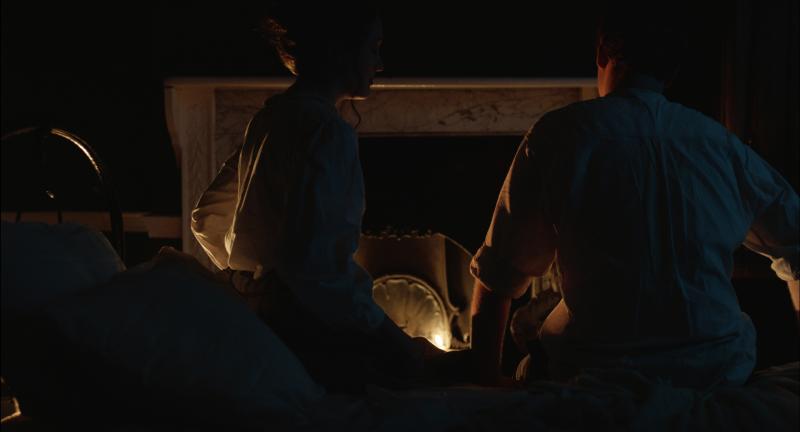
This sequence was shot in a very discreet and easy way (the normal way of shooting it I think – ha!)
First of all we had to find a room with dark walls to use it at “night time”. Once we found the room (in Ardgillan Castle in Dublin) we had two issues:
- Our first thoughts were to use “moonlight” from the outside, I mean placing a light out of the window. We could not do so as the room was in a very high place and we did not have either cherry pickers or scaffoldings to place the light outside
- There is another part of the sequence where we see the girl opening a door. When the actress was opening the door we were seeing the castle’s hall and we had to create a 4×4 dark room in the hall (we were shooting at daytime), put some furniture there and create a little bit of ambience.
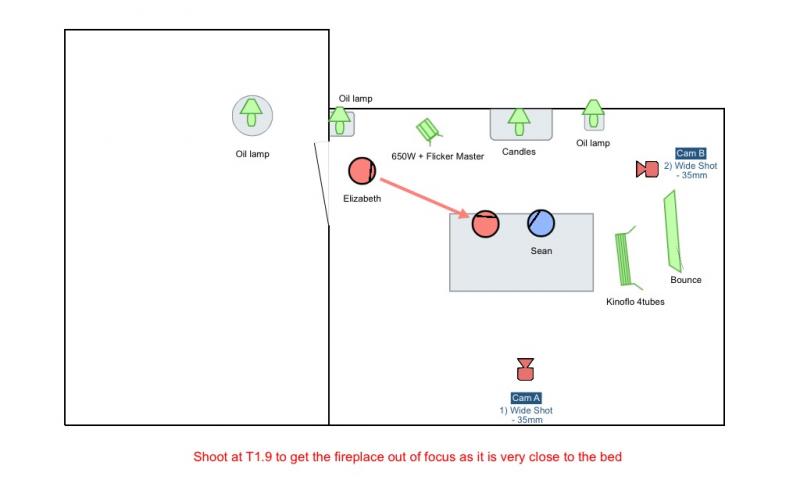
I wanted to get more information in the dark part of the curve so I rated the camera at ASA 400 rather than ASA 800, that way I could have 1 more stop of “darkness” As we knew that those were going to be our problems when shooting, we decided to go with an easier approach, and here is how we lit the sequence.
Frame 2

We don’t have a lot of sun in Ireland, but when it is there, it is beautiful so we tried to get the most out of it in the only day (out of 7) that we could get it. This is what we got.
Frame 3
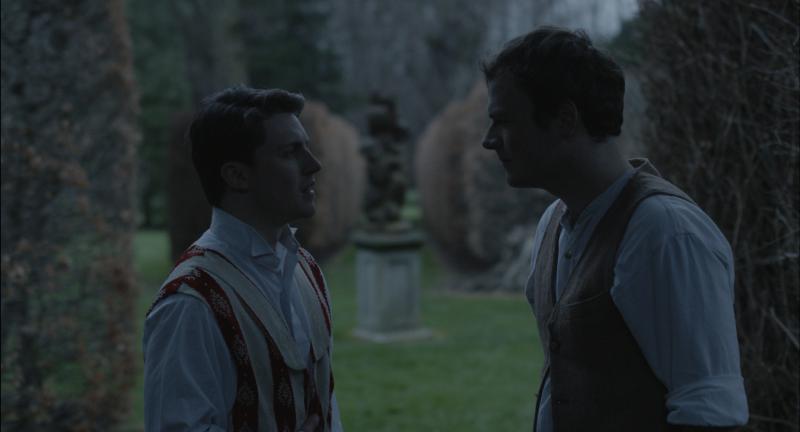
This sequence is a very interesting part of the short – film where two of the characters fight verbally. I love cinema because of a lot of reasons, one of them is that it is something very organic and a super creative process made by a team. This part of the story was shot under a very cloudy sky in the last part of the day. To be honest I wasn’t very sure if I had to shoot or not as I was seeing the actors in front of me while rehearsing and I couldn’t make anything out it. The location was pretty but the light was absolutely dull and boring. After two minutes trying to decide what to do I said: Eh, let’s place a frame with a black silk above the actors so I can add more contrast and a bit of mood. The place was so narrow and tight that there were no space for the tripods so we had to hang the frame on top of the bushes.
Frame 4

There is one thing that I do every single time that I shoot something, I spend one day in each location taking photos and writing notes so I can see how light interacts in the place. Probably because I’m always learning and I need to see and prepare everything in advance. Maybe it is because of the way I learnt to do things under Rodrigo Prieto’s and Janusz Kaminski’s wing. Hence, after visiting this location and seeing the pics I took, I saw one which was the kind of light I wanted for the sequence, a little bit claustrophobic with a sense of concern / worry (is this the right word?)
And I said: Let’s recreate it with artificial light!
I love finding the right spot to place a light at the very beginning of the sequence, that means that I don’t have to move it ever and I can shoot 360ª if needed. I know that some jobs might need different lighting set – ups for the same sequence or even more lights to shoot properly but at this stage of my life I like lighting places rather than actors or actresses, is it right or wrong, I don’t know, as I said, I’m still learning a lot and my approach might vary in a near future if I keep shooting things, who knows!
This place was full of challenges:
- It is a basement and the windows that you can see in the frame had a very very very narrow aisle (1 meter) between the windows and the wall. I couldn’t put any light there.
- Not only the aisle was very tight but also it was covered by bars on top of it, and I couldn’t hang anything inside the room as we didn’t have the permission to do so. So my light had to be placed outside and at least 1 meter above the windows. (Yeah!) And it was lit as you can see below.

Just some corrections to the diagram:
* I placed 2 x 2.5KW HMI as I knew the M18s weren’t going to give me the T – stop I needed.
* I couldn’t put any silk in the windows (it made sense just for the shoot number 3 but I didn’t have time to do it)
* There is no 2.5KW on the left side because I only had 2. I wanted to use a 575KW HMI but it was broken at that stage of the shooting and I ended up using a Kinoflo (I didn’t like the look of it but…)
Frame 5

The sequence where we got the frame above was a very difficult sequence.
- It had to be shot at night and we could only shoot on Ardgillan Castle from 8.45 am to 6pm so it was going to be impossible to get it shot at the right time.
- The room where it takes place is a very big room, 20 by 30 feet and it has 3 super massive windows and a door with huge window panes. As we couldn’t shoot at night we decided that we had to cover all the windows with black boxes, a very tough work as the electrical department had 1 gaffer and 2 sparks who did an amazing job through all the short – film.
- There were some difficult camera movements.
- As we could not do any kind of pre light, we were 3 people and we were not able to hang anything on the walls I had to spend 3 hours 1/2 to light it all and be able to shoot in any direction.
- To shoot all this sequence I could have placed 3 jemballs or chinese lanterns, however, I reckon a cinematographer has to experience with light as much as he / she can and short – films are a very interesting way to try new things and open your mind in a lot of ways. If I had chosen to use chinese lanterns, all the room had been lit with a base light and it would have lost all the mood and darkness I wanted to get.
- I discovered a very useful gel called “cyan”, myself and my gaffer were absolutely amazed by the quality of it and how nights were much more interesting while using it rather than using the Green Steel that we used in all the different movies we have shot together.
- The Alexa was rated at 400ASA also.
And the diagram below is how we filmed the sequence.
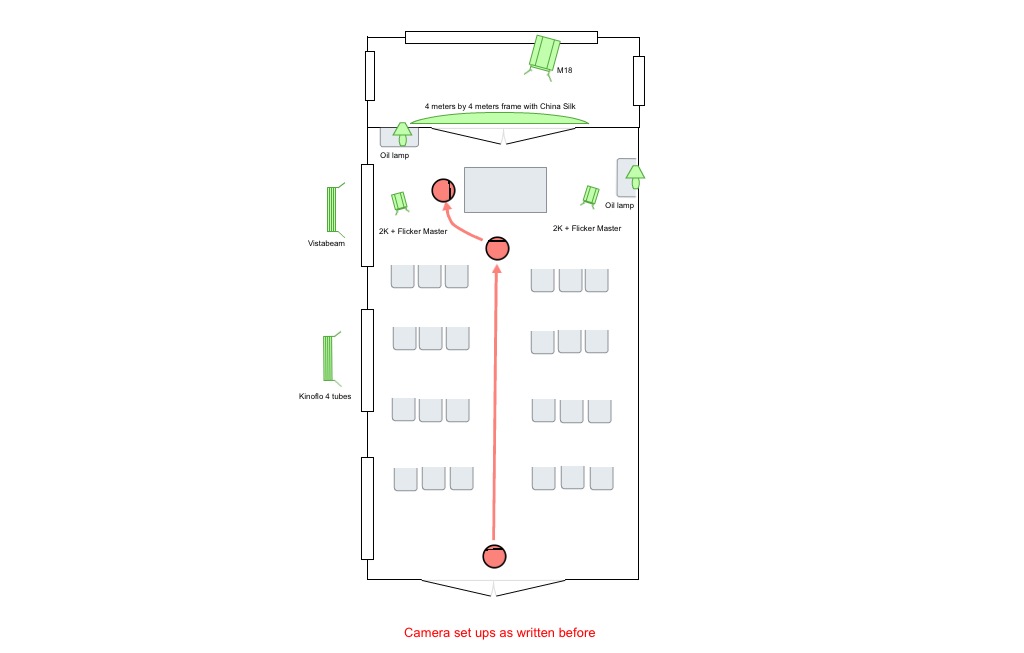
Definitely it was a very difficult piece to create, but we had very talented people working with us in all departments and without them, it would have been impossible to shoot it!
And that’s all! Hope you enjoyed the explanations! The short – film’s information is as follows:
Name: Staccato
Director: Eoghan McQuinn
Producer: Caroline Kealy
1st AC: Greg McGuiness and Niall Cullinane
2nd AC: Michael Gilbert
Gaffer: Raul Perez
Electricians: Oisin Lowry and Luke Bridgett
Camera Rental House: Panavision Ireland
Lighting Rental House: Cine Electric Ireland
If you want to take a look at some of my work, please go to www.miguelangelvinas.com or take a look at IMDB

by SeanBreathnach | Jul 5, 2012 | Cinematography, Education, featured, Short film
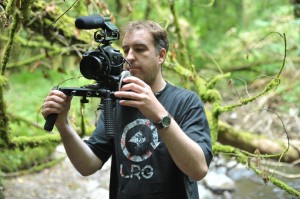
This week we interviewed one of the hardest working camera operator’s and D.O.P.’s in Cork, Paraic English.
Páraic has worked as DOP on dozens of films, including ‘Hungry Hickory’ (Short Film, Dir. Damien McCarthy) and ‘Penny’ (Short Film, Dir. Patrick O’Shea). He has shot and edited short films, documentaries, adverts, stock and catalogue Shoots in Ireland and abroad. A comprehensive list of credits can be seen on his IMDB page: http://www.imdb.com/name/nm3279826/
Every time I attend a film festival in Munster I see your name on films. Have you worked with everyone in Cork at this stage?
Nope. Cork is so small, crews and cast often overlap over different projects. It’s good for continuity and building working relationships but at the same time I’m always happy to hear new ideas from ‘strangers’ or strange ideas from ‘newbies’.
Are you shooting something at the moment? Can you tell us a little about it?
Ya always working away on something thankfully, it’s wedding season! I enjoy doing short promos, most recently one for an Opera Production, part of the Midsummer Festival. We have some scenes left to shoot for Kevin O’Neill’s upcoming short film too and a trip to the west of Ireland is in the offing soon too to shoot the CFC/RTE Short Script Award Film ‘Leanbh’. Other than that I’m kept busy freelancing for production companies grabbing B-Roll, talking heads and sunshine shots for corporate and event films. Trying to get my head around motion-controlled timelapse for a wee trip in August too. It’s complicated and I don’t have a head for figures.
How important is the script to you?
It’s the blueprint for months of planning and effort as far as production crew are concerned. However, there’s so much room between the words for actor performance, score, camera and pacing that I’m often thankful I’m only a techie. I rarely read it more than twice.
What is your favourite part of the job?
Apart from the early starts and late finishes? Eh, editing. That’s where it all comes together. You do get to see some cool stuff now and again. Film is something that can bring people together so that’s nice to be a part of.

What is the worst part of the job?
Multi-tasking. Keeping an eye on light continuity, eyelines, shooting for the edit, boom in shot, makeup, shadows, composition, moving the camera, the other cameras, unravelling the slate notes. You get the idea. You’d be knackered after it.
Who would you say your biggest inspirations are in film?
Werner Herzog, Roy Andersson, Robert Altman, Hitchcock, Fellini (for the madness and the moving camera), Scorsese, Orson Welles for Lady From Shanghai alone, I’m partial to a bit of Terence Malick too. Anything Jack Cardiff shot. I like the stylistic touches of Jean Pierre Jeunet & De Palma too sometimes. Roger Deakins is a great storyteller and shares lots of his techniques online too which is great for anyone with an interest. Laurel & Hardy films are always a winner.
What was the biggest challenge on your most recent film? Do you find the same challenges coming up again and again?
Ya always the same challenges. Smaller budgets mean short shoots in locations that often can’t be modified or adequately lit and sadly the lack of technical prep time can have consequences. Compared to the challenges of the production team they pale – everyone does the best they can with what they got. I have lots of admiration for anyone who actually makes a film, it takes a lot of guts.
How much have things changed in your line of work in the last ten years?
Very little. It’s more affordable in some ways to get a good image onscreen but a good story well told will never change. The internet is probably the greatest change. New market and a whole new set of imponderables.

Have you particular advice to give amateur film makers regarding camera work and lighting in their movies?
Fix it in post.
What do you think of the condition of filmmaking in Cork at the current time?
I’m optimistic. In the past, scripts may have fallen by the wayside but there now seems to be an appetite and personnel to see through projects to a high standard. Lots of distinctive original voices coming through. Ireland is a cinema-loving and cinema-literate nation. My wish would be that this would continue so we can make our mistakes now and if funding materialises in the future we’ll be in a better position to deliver something we can be proud of.

 The lighting equipment list was very short, as I said, I did not have a lot of time to put lights.
The lighting equipment list was very short, as I said, I did not have a lot of time to put lights.






 Working with an Arri Alexa
Working with an Arri Alexa










